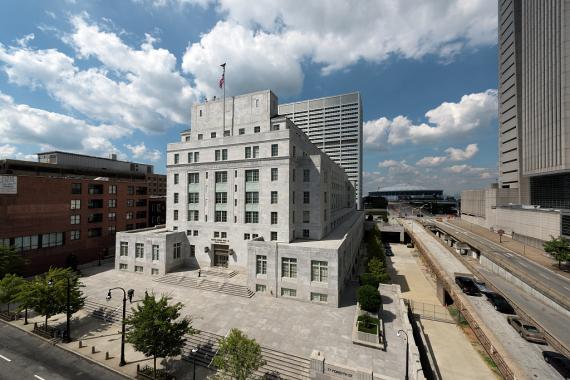Location: 77 Forsyth St SW, Atlanta, GA 30303
History
“This building was designed and constructed to accommodate the rapidly expanding volume of the Postal Service, which was then oriented around a single, central processing facility. The Martin Luther King, Jr. Federal Building and its features were “state of the art”, and reflected the growth of Federal institutions in America. Furthermore, its various links with the Terminal Station, formerly located across Spring Street, reveal the Post Office’s reliance on the railroads prior to the rise of Airmail service and long range truck oriented mail routing.
The size, scale and character of this building reflect the growth of the Federal government as an institution. It is also noteworthy as being relatively typical of other Federal buildings of the era, and by being built by the Work Projects Administration which offered employment to construction workers and craftsmen.” (from HSR, p. 12-13)
Architecture
The Modernistic style of the Federal architecture of this period has since become described as “starved classicism”. It evolved as a response to the larger spatial requirements of the institutional functions, and the setback requirements and cubic massings of the buildings. As the differentiation of the specific functions became absorbed into the general organizational scheme, the individual articulation and traditional ornamentation began to be reduced, or disappeared altogether. This ‘block-style’ of massing was well suited to the greatly increased scale of the larger buildings, and the spirit of Art Deco decoration complimented the rectilinear spatial massing and the play of horizontal and vertical planes and lines.” (from HSR, p.2.)
Three building materials and Modernistic details mark the elevations of the Martin Luther King, Jr. Federal Building. Pale gray to white granite clads all elevations at the lowest three levels. Limestone covers the walls of the first through seventh floors except on the south elevations where yellow brick is used on the recessed facades of the third through seventh floors. The massing is square and blocky, and the Art Deco inspired ornament includes fluted piers plus chevrons and other stylized bands of ornament. Terra-cotta is used for the narrower bands; the wide bands are limestone. On the east and west elevations, the main entrances are further marked by handsome doorways. The nickel alloy and glass doors are surrounded by decorative nickel alloy bands, and a large panel with two eagles surrounding a shield is depicted in low relief above the doors. Transom windows at the Forsyth Street entrance are protected by a decorative nickel alloy screen. The numerous building setbacks have requisite flat roofs, with green terra-cotta shingle tiles crowning the hip roof of the seventh floor.
The interior spaces are organized around a long, central corridor with the primary lobbies and vertical circulation being located at both the east and west ends of the building. Art Deco ornamentation and nickel alloy details are repeated in the East Lobby, the original U.S. Postal Service Lobby, with various colors of marble replacing the limestone of the exterior as the wall material. The West Lobby has similar, though greatly simplified, details, as do Stairs #1 and 2 which ascend from these two areas. Other original interior details include wood paneled doors and molded wood door casings, terrazzo floors with marble borders in the fifth and sixth floor corridors, brick wainscot in portions of the basement corridor, scattered areas of baseboard, and numerous original restroom finishes and their plumbing fixtures.
Most interior spaces, however, sport completely new finishes including vinyl and paper wall coverings, carpet, suspended acoustical ceilings, and demountable partitions. Entirely new floors have been inserted at the first and second floor mezzanine levels, in areas which had been the upper parts of the floors below.
Facts
- Architect: A. Ten Eyck Brown
- Construction Dates: 1931-1933
- GSA Building Number: GA0007ZZ
- Landmark Status: Listed in the National Register of Historic Places

 U.S. General Services Administration
U.S. General Services Administration
